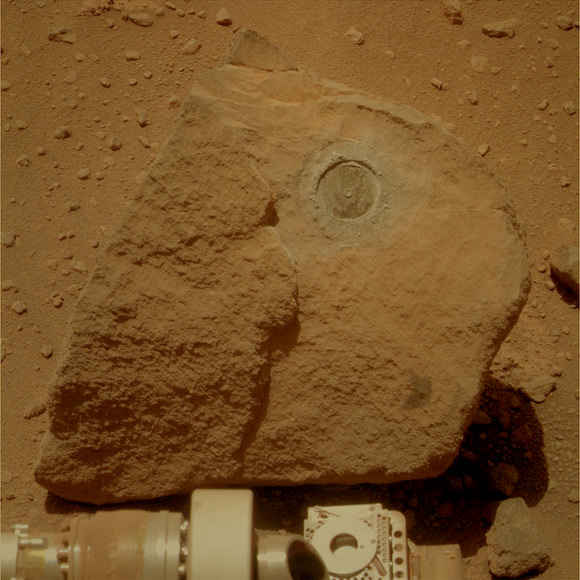[/caption]
Caption: Opportunity leaves a mark on the Marquette Island rock on Mars. Credit: NASA/JPL/U of AZ, colorization by Stuart Atkinson
The Opportunity Mars rover has been sitting by a rock called Marquette Island since early November 2009. The stay has given the rover a bit of a respite from the "pedal to the metal" driving regimen in its attempt to get to faraway Endeavour Crater. But Oppy hasn't been just soaking in the rays, or kicking back doing nothing. She's been conducting a thorough examination of the rock, and on Sol 2110 (Dec. 24, 2009), Oppy's Rock Abrasion Tool dug in and left a mark on Marquette Island, a 1.5 millimeters (0.06 inch) hole. Then subsequent observations of the hole were made by the microscopic imager, to create a close-up mosaic of the innards of the rock, and the Mössbauer spectrometer was positioned on a different rock target for a long integration. Stu Atkinson created this colorized version of Oppy's latest look at Marquette. After the rover hits the dusty trail again, will humans ever see Marquette Island again?
Stu has a few thoughts on that: "In a hundred years this rock will be on display in the Museum of Mars - just down the hall from the "MER Gallery" where Spirit and Oppy are displayed in all their restored glory," Stu told me, "and there'll be an attendant on duty beside it all the time, to stop tall, pale-skinned martian kids on school trips from leaning over the barrier and poking their dirty, sticky fingers into the hole Oppy ratted in it."
Ah, yes! I've always loved Stu's optimism! Check out more of his thoughts on his blog,
Cumbrian Sky.
But back to the here an now, the plan ahead for Oppy is to collect an alpha particle X-ray spectrometer (APXS) spectrum and a MB spectrum from the RAT hole, before resuming the drive toward Endeavour crater. Obviously, the science team must find Marquette Island quite interesting to spend so much time there, and it will be interesting to hear the results of the observations.
As of Sol 2110 (Dec. 24, 2009), Opportunity's solar-array energy production was 315 watt-hours with an atmospheric opacity (tau) of 0.491 and a dust factor of 0.509. Total odometry was 18,927.56 meters (11.76 miles).
Source:
Mars Rover website
 Universe Today
Universe Today
